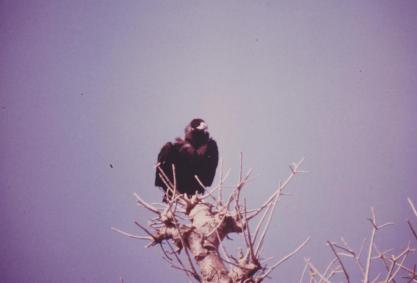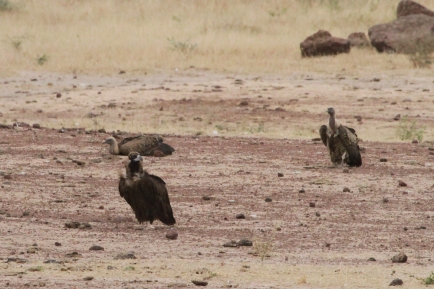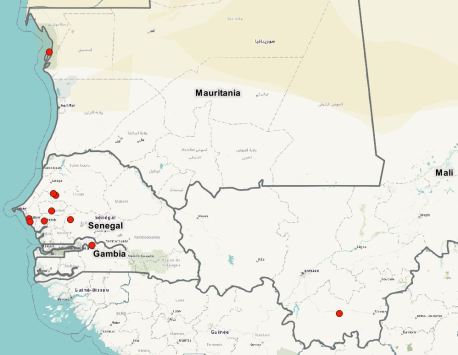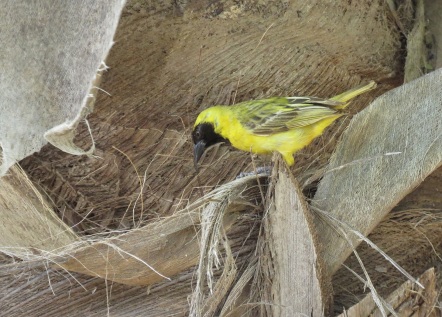Cinereous Vulture in West Africa: from vagrant to regular visitor?
Cinereous Vulture is considered a rare vagrant to sub-Saharan Africa, with just a handful of observations from the western Sahel, mainly from Senegal but also at least one from Mali. Last winter several new records were obtained from the region, including two from Senegal and the first observations from The Gambia and Mauritania.
Last winter’s records from Senegal, Gambia and Mauritania were described in a series of three posts on the MaghrebOrnitho blog (highly recommended for anyone interested in birds of NW Africa!), while the previous record, from 2013, was reported on SenegalWildlife. However, the first Senegalese record of the species was never published and it’s only recently that it was uploaded onto eBird, now also with photographic documentation. It was seen north of Diourbel on 6 January 1987 by a British group. As such, it’s probably a good thing to set the record straight, and recap all known records from Senegal.
The 1987 observation was reported to François Baillon, who at the time was running the French overseas research institute (ORSTOM, now IRD) in Mbour. In a hand-written letter he confirmed that there were no previous records from Senegal, adding that he has seen a great diversity of raptors in this central region of Senegal, including Egyptian Vulture, Lappet-faced Vulture, White-headed Vulture (now very rare here!), Lanner, Peregrine, Lesser Kestrel, Short-toed Eagle, Beaudouin’s Snake-Eagle, Booted Eagle & Bonelli’s Eagle. Of note is that the same group also saw a group of Mottled Swifts during their tour, right by the Gambian border on January 3rd 1987 (“20+ feeding over bush fire. The birds were seen immediately after crossing into Senegal and may well have crossed into Gambia as well.”) – prompting Baillon to mention that he has regularly seen Mottled Swifts in the Niokolo-Koba in January & February 1986 as well as in February 1987 near the river Gambia. Anyway, back to our vultures…
As it turns out, this first country record was also the first for Africa south of the Sahara, given that it predates the record of a Spanish-ringed bird found dead in Mali’s Sikasso region on 19 January 1995. This means that there are now at least seven observations from Senegal, listed here in chronological order:
1) 1987: an immature north of Diourbel on 6.1.87, pictured above (N. Lethaby, P. Thompson et al.)
2) 2005: a bird ringed in Spain was recovered in Senegal in January 2005 (in HBW; no precise date is given and no further location info is available, though I assume that it’s the Mbour area as shown on the map with ring recoveries in this publication by de la Puente and colleagues, 2012).
3) 2005: an immature between Louga and Touba on 23.2.05, reported by Vroege (2013): Immature Cinereous Vulture Aegypius monachus in Senegal in February 2005. ABC Bull. 21: 223-224. See also this article, in Dutch with English summary.
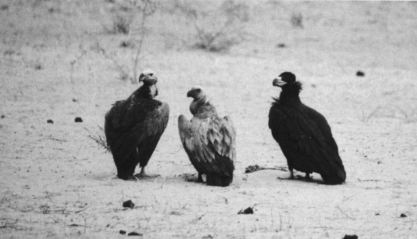
Cinereous Vulture / Vautour moine, February 2005 (K. de Vet)
4) 2007: an immature photographed at Nianing (south of Mbour), on 13.1.07 by Talamelli (2007a, 2007b). This observation was incorrectly assumed to be the first record for Senegal.
5) 2013: an immature near Tiom in the Khelcom area (north of Kaffrine) on 23.1.13, with a hundred or so other large vultures at a carcass (L. Majorel, L. Puch et al.), reported on this very blog here though at the time incorrectly referred to as the second record for Senegal.
6) 2018: one near Fatick on 30.1.18, photographed by Julio Rabadán González (two photos on observation.org), see also last picture in this post.
7) 2018: one at Sagata (east of Kebemer, along the road to Doyene Dakhar) on 26.2.18 photographed by a Dutch tour group, different from the Fatick bird – see the MaghrebOrnitho post for more details on this and the previous observation.
Just two days prior to the Sagata observation, a Cinereous Vulture was filmed and photographed while feeding with other vulture species at a vulture feeding station run (apparently illegally so!) by a Spanish group, the first record for Gambia. And the first for Mauritania was photographed just a couple of months earlier, on 9.12.17 in the Banc d’Arguin area. The latter was ringed as a chick in the Sierra de Guadarrama near Madrid on 13 July 2017.
The map below shows all of the above observations, i.e. all records from sub-Saharan Africa plus the one from Mauritania (the location of the Malian record is approximate as no precise locality was given).
With at least three birds involved between The Gambia, Senegal and Mauritania, last winter’s records likely reflect a real increase in numbers rather than just an effect of any hypothetical better observer coverage. This trend is fairly obvious in Morocco, particularly at Tanger on the African side of the Strait of Gibraltar, where no less than four birds were seen on a single day last year, on November 10… Even more impressive, the same day the team counted some 2,700 Eurasian Griffons here – that must have been quite a sight!! Further details here. It’s actually quite possible that some of the recent West African sightings were of one or several of these four birds seen at Jebel Moussa. Formerly considered an accidental visitor to Northwest Africa after going extinct as a breeding bird, Aeypius monachus is now seen as “a regular migrant and wintering species in small numbers” according to MaghrebOrnitho.
Cinereous Vulture – formerly often referred to as Eurasian Black Vulture – is classified as Near Threatened, mainly because the global population is relatively small (7,800-10,500 pairs, roughly equating to 15,600-21,000 mature individuals) and because there have been continued declines in the Asian parts of its range. In contrast, the European population is doing pretty well it seems, particularly in Spain which has seen increases possibly over 30%, with estimated total breeding population of some 2,440 pairs. After having seen the species for the first time in northern Greece many years ago, I was fortunate to see some of the Spanish birds during a visit to Madrid last January, right on the outskirts of the city while waiting for the local Spanish Imperial Eagles (which eventually did show up – a long overdue lifer… and a potential vagrant to West Africa!). A reintroduction scheme in southern France lead to the establishment of a small population there, and the species is becoming a regular summer visitor to the western Alps during post-breeding dispersal.
This massive all-dark vulture is pretty straightforward to identify and should be easy to pick up among the local vultures and wintering Eurasian Griffons, which they often seem to associate with. The few records so far show that the species can show up pretty much anywhere north of The Gambia, though the “Vulture Triangle” centered roughly on Louga, as well as a central belt stretching from Mbour to the Khelcom, are clearly more likely to yield more observatins. Let’s see if the current trend continues, which given the increase in Western European populations seems rather likely.
Many thanks to Mohamed Amezian (MaghrebOrnitho) for making available a great deal of info on the species, and to Nick Lethaby and Paul Thompson for sharing their 1987 observation.
La Tabaski à Palmarin

Le weekend dernier, c’était la grande fête de la Tabaski ici. Les villes du pays se vident, tout le monde rentre au village, et un demi million de moutons sont sacrifiés. Nous en avons donc profité pour s’éclipser pendant quelques jours dans le delta du Saloum, plus précisement à Palmarin où nous avons passé trois nuits dans l’agréable écolodge à Diakhanor. Petit récit en images.
D’abord les limicoles, avec ce couple de Rhynchées peintes vues dans une flaque d’eau douce dans le secteur des lagunes. De l’eau, il y en a cette année! Bien plus que l’an dernier à la même époque, au point où les quelques villages de la commune sont en grande partie inondés… L’oiseau très coloré de gauche est la femelle: le dimorphisme sexuel est inversé chez cette espèce si particulière, le mâle se chargeant de l’incubation pendant que Madame va voir ailleurs.
Comme toujours, les limis sont nombreux: quelques centaines de Bécasseaux cocorlis, dizaines de variables, quelques Sanderlings, les Chevaliers gambettes, guignettes, aboyeurs, sylvains et stagnatiles, Grands Gravelots, Barges rousses et à queue noire (dont deux hollandaises avec bagues couleurs), quelques Tournepierres, un Huîtrier pie, 2-3 Courlis cendrés et beaucoup de corlieux.
Chez les laridés, c’est bien sûr le Goéland brun qui domine, suivi de près par les Audouins dont une estimation grossière résulte en un total respectable d’au moins 400 oiseaux dont pas moins de 32 (!) individus bagués. La plupart sont espagnols, mais cette fois je trouve aussi trois italiens et cinq portugais. Je reviendrai sur l’évolution de la distribution de cette espèce au Sénégal dans un autre article, disposant maintenant d’une bonne centaine de données de lectures de bagues.
Suite à la saison de nidification, il y a à cette époque de l’année enormement de Sternes caspiennes à Palmarin, avec par exemple environ 3’100 individus dans la lagune de Diakhanor le matin du 2/9 – et c’est sans compter les centaines voire milliers d’oiseaux dans les lagunes juste au nord de Ngallou au petit matin du 4/9, dont une partie est visible sur la photo d’en-tête.
Assez peu de rapaces sont vus: 2-3 Faucons chicqueras, un Elanion blanc, onze Vautours de Ruppell au dortoir à Ngallou, un Gymnogène le long de la route Joal – Samba Dia (où l’on voit également une Ombrette, exactement au même endroit que l’an dernier en novembre).
Ensuite quelques passeraux, à commencer par cette Veuve dominicaine en plumage nuptial, tout comme les autres viduidés (veuves) et les plocéidés (tisserins, euplectes). Les rectrices de cet individu sont encore en train de pousser et peuvent facilement atteindre le double de la longueur de l’oiseau.
Deux Gobemouches noirs seront les seuls passereaux migrateurs nordiques que j’observe, dont un individu qui m’a paru assez inhabituel car présentant un plumage encore très “jeune”, étant nettement tacheté, et avec pas mal de blanc au bout des moyennes couvertures: Gobemouche noir classique, ibérique, de l’Atlas? Difficile à dire à ce stade, mais je vais essayer de creuser la matière un peu plus lorsque j’en trouverai le temps. (J’écris ces quelques lignes depuis Bamako, où il y a visiblement pas mal de Gobemouches noires en escale en ce moment!)
Pour terminer deux reptiles fort sympathiques: une femelle d’Agame des colons (ou “Margouillat“), et ce qui semble être une Couleuvre sifflante, trouvée dans un arbre de l’écolodge grâce au vacarme des Bulbuls des jardins, Souimangas à poitrine rouge et autres Barbions à front jaune.
Et pour une fois, on finit par un poisson… sauf erreur une espèce de la famille des Tetraodontidae, qu’on trouve assez régulièrement échoué sur les plages sénégalaises.
The Dakar Vultures once again / Les vautours dakarois, une fois de plus

(version française en bas, sous les photos)
Short post today, simply to announce that last month a paper on our study on Dakar’s Hooded Vultures was published in Ostrich, the Journal of African Ornithology.
“The decline of an urban Hooded Vulture population in Dakar, Senegal, over 50 years” describes in more detail the findings that were presented at last year’s PAOC by lead author Wim Mullié, and is part of a special vultures issue of the journal. This allowed us to further refine our analyses and to dig a little deeper into the possible causes of the important decline – which even if they remain unconfirmed hypotheses, are likely to provide better insights into the species’ requirements in terms of feeding, nesting and roosting. And which hopefully will contribute to specific protection measures.
I’m pleased to announce that I can share the paper freely through this blog, hoping that it may be of interest to some of our readers: click HERE to download the PDF version of the article (2 MB); for those with less time I’ve copied the abstract here:
As in many West African cities, in Dakar Hooded Vultures Necrosyrtes monachus have always been characteristic urban scavengers. The recent decline of Hooded Vultures in other parts of Africa, mainly eastern Africa, has been the reason in 2015 for up-listing of its status by the IUCN in the Red List of Threatened Species to Critically Endangered. As the Hooded Vulture is still common in the Lower Casamance, Senegal, in the Western Region of The Gambia and in Guinea-Bissau, without clear signs of a recent decrease, a survey of its current status in Dakar was undertaken and compared with historical data over the past 50 years. A strong decrease of >85% was noted from 3 000 individuals in 1969 to 400 in 2016. This decline is on the high end of the decline noticed over much of its range but in striking contrast with the apparently stable populations along the West African coast more to the south (The Gambia to Guinea). Likely causes are (1) exponential urbanisation resulting in loss of feeding sites and reduced food availability, (2) increased poisoning of feral dogs with strychnine sulphate due to an upsurge of rabies and (3) increased disappearance of suitable trees for nesting and roosting.
Fred Bacuez kindly informed me that the paper was also referenced on the website of the Vulture Conservation Foundation, who highlight the importance of the Vulture Multi-Species Action Plan (MsAP), which “includes all African vulture species [and which] will hopefully be approved by all signatory states in the next Conference of the Parties this fall, and will then be a significant tool to address these massive poisoning incidents and therefore revert the continuing decline of African vultures.” This is much needed of course, but ultimately it will come down to implementing substantial conservation actions – a large part of which comes down to sensitising and educating local communities, and to adequate law enforcement to stop the trade in vulture parts.

Hooded Vulture / Vautour charognard imm. aux Almadies

Hooded Vulture / Vautour charognard ad. aux Almadies
Billet rapide (mais bilingue!) aujourd’hui, simplement pour annoncer la publication, le mois dernier, de l’article résultant de notre étude sur les Vautours charognards de Dakar, dans le journal d’ornithologie africaine Ostrich.
Intitulé “Déclin d’une population urbaine de Vautours charognards Necrosyrtes monachus sur 50 ans à Dakar, Sénégal”, l’article décrit de manière plus détaillée les résultats que Wim Mullié, l’auteur principal de l’article, avait déjà présentés lors du congrès d’ornithologie panafricain (le PAOC) l’an dernier, et fait partie d’un numéro spécial sur les vautours. Ceci nous a permis de creuser un peu plus les analyses et surtout les causes possibles du déclin important – qui même si elles restent à l’état d’hypothèses non confirmées, peuvent aider à mieux comprendre les besoins de l’espèce en matière de nourrissage, reproduction et reposoirs. Et qui, nous l’espérons, pourront contribuer à mettre en place des mesures de protection spécifiques.
J’ai le plaisir de partager l’article à travers ce blog, en espérant qu’il soit utile pour nos lecteurs: cliquez ICI pour télécharger la version PDF (2 MB); le résumé est repris ci-dessous pour ceux qui n’auraient pas le temps (ou l’envie!) de lire l’article entier:
A Dakar, comme dans de nombreux centres urbains de l’Afrique de l’Ouest, les Vautours Charognards Necrosyrtes monachus ont toujours été des charognards caractéristiques de ces villes. Le récent déclin des Vautours charognards dans d’autres parties de l’Afrique, principalement en Afrique de l’Est, a motivé, en 2015, son inscription sur la Liste rouge de l’UICN comme espèce menacée « En danger critique d’extinction ». Cependant le Vautour charognard est encore commun en Basse Casamance (Sénégal), dans la partie occidentale de la Gambie et en Guinée-Bissau sans indicateurs d’un déclin de sa population. Ainsi une enquête sur son statut actuel à Dakar a été menée afin d’effectuer une comparaison avec les données disponibles des 50 dernières années. Une forte baisse (>85%) a été notée de 3 000 individus en 1969 à 400 en 2016. Ce déclin correspond aux chutes des populations ailleurs en Afrique mais contraste avec les populations apparemment stables de la Gambie à la Guinée. Les causes probables de déclin sont (1) une urbanisation galopante entraînant une perte de sites d’alimentation et ene réduction de la disponibilité de nourriture, (2) une intoxication accrue de chiens sauvages avec du sulfate de strychnine due à une recrudescence de la rage et (3) une disparition accrue des arbres appropriés pour la nidification et le repos.
Fred Bacuez vient de m’informer que l’article a été mentionné sur le site web de la Vulture Conservation Foundation, qui soulignent l’importance du Vulture Multi-Species Action Plan (MsAP), qui “inclut toutes les espèces de vautours africains [et qui] sera, on l’espère, ratifié par tous les Etats signataires lors de la prochaine Conférence des Parties cet automne, et qui deviendra alors un outil important pour remédier aux incidents d’empoisonnements massifs en vue d’infléchir le déclin continu des vautours africains.” C’est très nécessaire bien sûr, mais à la fin du compte ce ne sont que des actions concrètes qui pourront aider nos vautours – ce qui revient en grande partie à la sensibilisation et à l’éducation des communautes locales, et à l’application effective des mesures légales pour mettre fin au commerce des parts de vautours.

